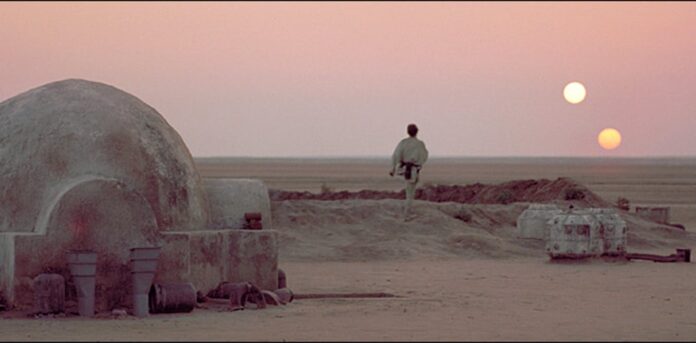By: Adrian Tre
Publisher: Ghoulish
Date: NA
A look at the more subtle side of how the Star Wars franchise creates its universe.
Ok, let’s start with the obvious; I don’t have to tell you what Star Wars is. Everybody knows about Star Wars, even if they have never seen a single movie in the series, I can guarantee you that they can name at least 5 characters. It’s the single most popular franchise in film history. Of course, there are a lot of things that contributed to making this movie about space wizards such a success. You can talk about the classic hero’s journey story structure; the archetypal yet distinct characters; the iconic performances by A-list actors; the simple conflict between good (the Jedi and Rebellion) and evil (the Sith and Empire).
But that alone isn’t what makes Star Wars special. After all, both sides of the conflict are pretty simple and generic once you get down to it. The empire is cartoonishly evil – they draw a lot of inspiration from Nazi Germany and American imperialism, but they don’t really have a developed ideology beyond being evil for the sake of evil, murdering entire planets for basically no reason other than fear and power. The rebellion is similarly plain, and the Jedi and Sith are also a normal good/evil binary.
But if the main conflict is so morally simple, why have people obsessed over Star Wars for so many years? The key, I think, is not on the big plot and characters, but on the background elements – the set dressing, if you will.
Now back in 1977, this was considered a pretty weird freaking movie. That’s why it starts with a text crawl to introduce the main conflict – if you jumped right into the action without any prior knowledge, you’d probably be pretty lost. This movie opens up with two weird robots with distinct personalities (and one of them can’t even speak), stranded on a planet with a bunch of aliens. It’s only later that we meet our conventional human protagonists, but the pacing is so tight that you don’t even notice that you just spent the first 20 minutes following droids instead of people. Just in the opening scenes, we see:
- Robots that can talk
- Robots that can’t talk
- A princess
- Lasers that kill people
- Lasers that don’t kill people
- Hooded small people that ride around on a castle on wheels
- An evil cyborg samurai wizard
By all accounts, this should be too much for the audience. And yet it isn’t, because we are given just the right amount of information. We know who the good guys and bad guys are, we know the Empire is after the droids, and that’s it. No need for a long backstory explaining how the empire rose to power, or what the Jawas are. It shows a lot but doesn’t explain more than needed. And this, I believe, is key to the series’ enduring popularity.

Star Wars Strength is its Visual History
While the mainline movies focus primarily on the Empire and rebellion, there are countless weird aliens, robots, bounty hunters, and assorted weirdoes littered throughout the galaxy. These creatures usually don’t get much more than a few seconds of screen time (at least in the movies themselves), but are still very recognizable, thanks to the amazing job by the costume designers, puppeteers, and concept artists. It really makes the universe feel alive and lived-in, especially in the original trilogy (which I’m going to be focusing on in this article).
Every background muppet in these movies has a distinct design and personality, and many wear strange clothing that looks like it’s been worn for a while. The general aesthetic of the Star Wars universe isn’t just alien, it’s old. The props and costumes have a clear sense of history, everything’s dusty and imperfect, just as it would be in real life.
When you look at a background character in Star Wars you aren’t just looking at a random extra; you’re looking at a character that clearly has its own history and businesses, that might not even have anything to do with the Empire or Jedi. You might never learn what their deal is, or even their name – but there’s a story here.
And whatever you imagine could be more interesting than any rebellion against an evil Empire. As funny as it may seem, there’s a reason Star Wars fans tend to obsess and write so much about random background characters; we want to know about these characters. They aren’t forced to be intertwined with the Empire vs Rebellion plotline, so they can have entirely different and stranger conflicts.“Mos Eisley Spaceport. You will never find a more wretched hive of scum and villainy. We must be cautious.”
Perhaps the best example of this ‘show, don’t tell’ rule is in one of the most iconic scenes in the entire saga; the Mos Eisley cantina. This is a perfect showcase of the kind of worldbuilding I’m talking about here. From the moment our heroes enter this place, we are shown loads of strange critters, most of which only get a couple of seconds of screen time.
A werewolf with red glowing eyes, a short cosmonaut, some kind of yeti-sloth, an actual devil – all of these random aliens have a distinct look that sparks one’s imagination. When a deformed human-looking alien is harassing Luke, his mentor Obi-Wan pulls up a lightsabre and chops off the guy’s arm. All the aliens stop for a moment to look at the mess and then go about their businesses as if nothing had happened. This alone tells us more about what this place is like than any exposition dump ever could.

For another example, let’s take a look at one scene from The Empire Strikes Back, where we’re introduced to a group of bounty hunters gathered by Darth Vader. For starters, all of them have interesting designs that make them stand out; we have a lizard man in a yellow jumpsuit, a bug-headed droid, a rusting robot with knives strapped all over it, among others. Of course, the standout is a human in green, red, and yellow armor: Boba Fett, one of the most popular Star Wars characters ever.
And yet, as many have pointed out, he has less than 10 minutes of screen time and only 5 lines across the whole trilogy. At first glance, it seems ridiculous how popular he is considering how little he does in the movies themselves. But the costume design works wonders at making him feel like a character with his own history; between the old chipped paint of the armor, the strange missile backpack and visored helmet, or the fact that his face is never shown.
There’s this moment in Empire where Vader singles out Boba Fett when he says that he wants our heroes captured alive. “No disintegrations”, he says. What the hell did Boba do to make Darth Vader tell him specifically that he can’t disintegrate them? Why him and only him, and not say the knife murder robot? Later on, we see that Boba Fett finds and helps to capture the heroes, but where did the other bounty hunters go? What adventures did they live while trying to find Luke and company? There are stories there. And we don’t know any of them, because they’re not important to the main plot. And so the only thing we have is our imaginations.

Why do you think that in the 1980s you could find toys of pretty much every random weirdo that showed up in those movies? Because there is an entire galaxy of tales to be discovered. Now obviously, with the gargantuan amount of Star Wars content that exists, you probably can find the answers to these questions. I’m sure every denizen of Jabba’s palace has a Wookiepedia article several paragraphs long. But that’s not the point.
If the success of the recent Mandalorian show is anything to go by, people like the weirder aspects of Star Wars. People want to see more of this universe beyond the Empire and Rebellion. Look at how many people love Mando and Grogu, even though one barely shows his face and isn’t force-sensitive, and the other is a puppet that can’t speak.

I guess the main takeaway is that, if you want to create a universe that feels lived in and realized, pay attention to the background extras. Make sure that they all have distinct and memorable designs. Maybe give them a single memorable moment in the spotlight, and you’ll see loads of fans demanding to see more of them.
Source: https://ghoulishmedia.com/star-wars-subtle-worldbuilding/
Comment: The Star Wars universe is renowned for its masterful world building. One aspect of this world building that differs from other franchises such as Alien or Harry Potter is the background characters and context. The sheer variety of characters that can be seen in the cityscapes of Star Wars is enough to keep viewers returning again and again. We can easily find ourselves tantalized by the faces and stories of characters we may never get to know, but their presence somehow still fascinates us. Harry Potter has a range of background characters that are easily dismissed. There are simply other children in school robes blending in with the attire of the main characters. Star Wars on the other hand gives its background characters unique looks and clothing all worn from battle, space craft maintenance, or an assortment of other in canon jobs. This gives a depth to the universe that is much like our own. Our daily lives involve change all the time. It is a dynamic existence that we know to be true. The static existence of Hogwarts is simply not able to compete with something as dynamic and changing as Mos Eisley spaceport or the underground of Coruscant.




